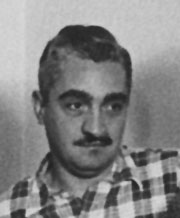
He was born in the city of Rosario, Santa Fe, in 1923. As a small child his family moved to Buenos Aires. Together with his brother Enio Iommi, he began his artistic studies at his father’s sculpture workshop. Later, he studied drawing with Fornells, and attended the Escuela de Bellas Artes Manuel Belgrano in 1939. In 1941 he studied under Antonio Sibellino. In 1943 he left the institution after signing the Manifiesto de cuatro jóvenes (Manifesto from Four Young men (Girola, Maldonado, Hlito, and Brito) against the guidelines of the education there imparted.
His first figurative sculptures soon turned into planes unfolded in space which sometimes presented incisions or acquired oblique, horizontal or curved directions.
In Argentina he participated in the Asociación Arte Concreto-Invención, and together with the Group MAC of Milan, he exposed his works in the Italian city of Como. During this period he worked alternatively in Paris and Milan, where he had an individual exhibition at the Libreria Salto.
As a member of the Grupo de Artistas Modernos de la Argentina (Group of Argentine Modern Artists), he exhibited his works at the Viau Gallery (1952) and at the Krayd Gallery (1953), where he also participated in the Orientaciones actuales de la escultura (Present Trends of Sculpture) exhibition. He settled in Chile, where he had his works exhibited in Viña del Mar and Santiago de Chile, and was professor at the School of Architecture of the Catholic University of Valparaiso.
He was awarded the Braque Award granted by the Embassy of France in 1963. In 1968 he took part in the exhibition Más allá de la geometría (Beyond Geometry), held at the Instituto Torcuato Di Tella, Buenos Aires, and in the 11th Biennial Exhibition of Sculpture of Antwerp in 1971.
Gradually, he turned volumes into geometry, fracturing them and integrating their bases, in search for the conversion of the base mass into a main character for his work. From 1970 onwards he began to work in several sculptures that were located in open spaces, among them, Dispersa I (Dispersed I), Trehuaco (1986), and Monument to Athenea, Santiago of Chile (1987).
Besides his work as a sculptor, he developed an important poetic activity collaborating with the Revue de Poésie, Paris. The Catholic University of Valparaiso held a retrospective exhibition of his works in 1991, at the Parque de las Esculturas de la Municipalidad de Providencia Claudio Girola died three years later in Viña del Mar, Republic of Chile, the country where he produced the greatest part of his artistic work.